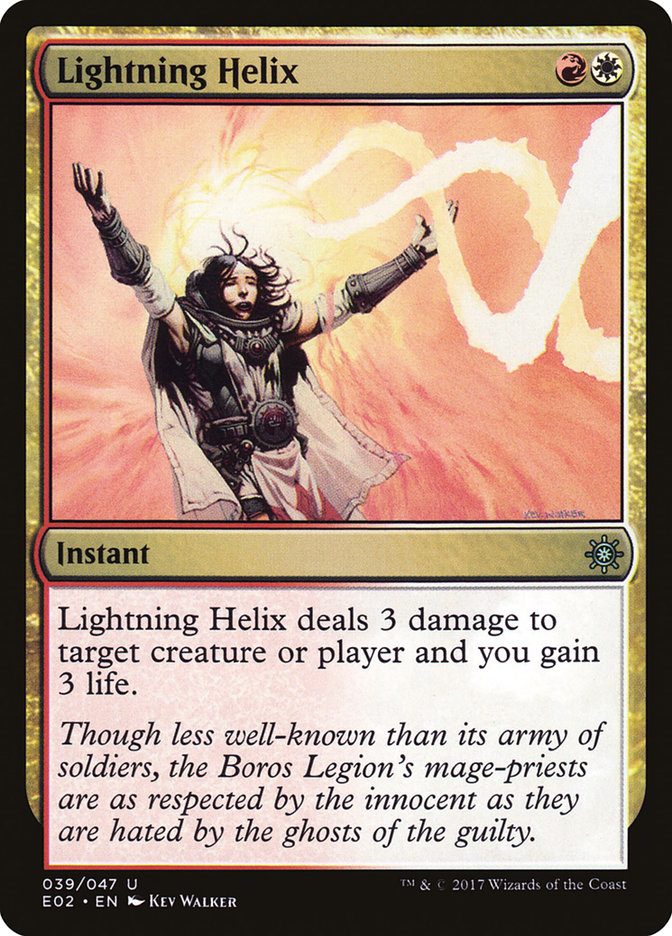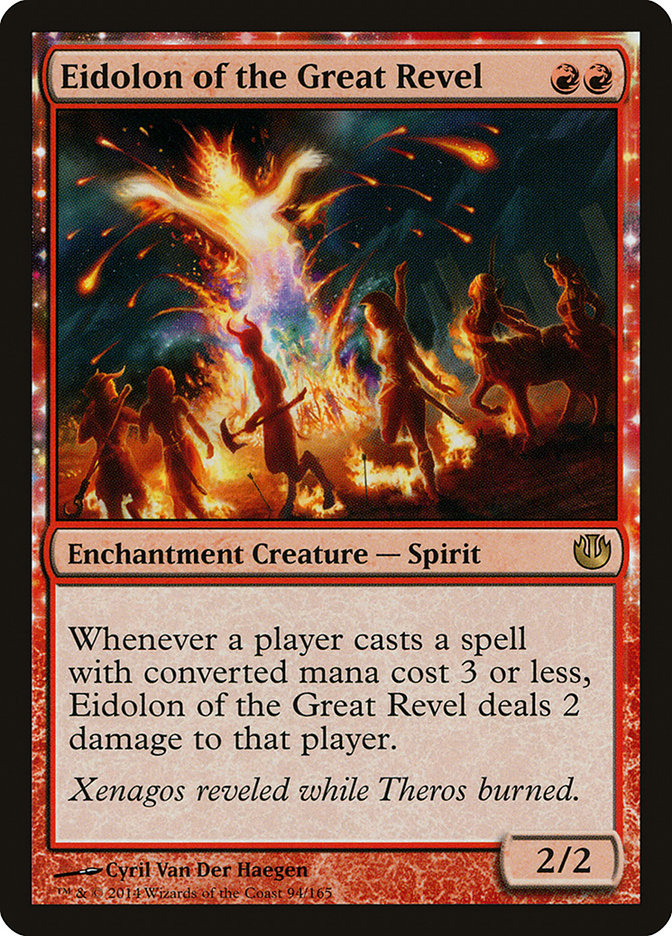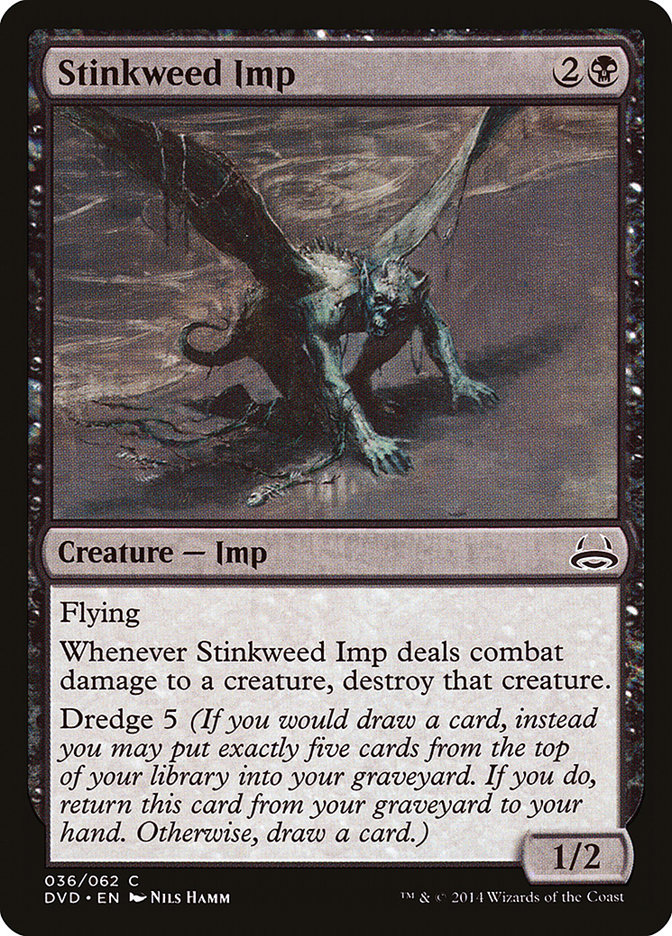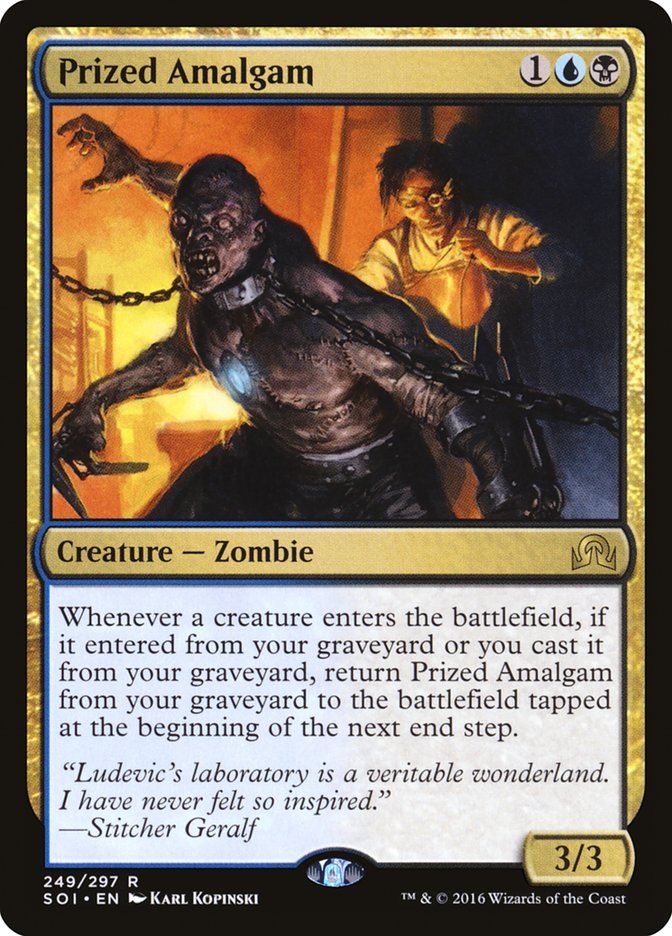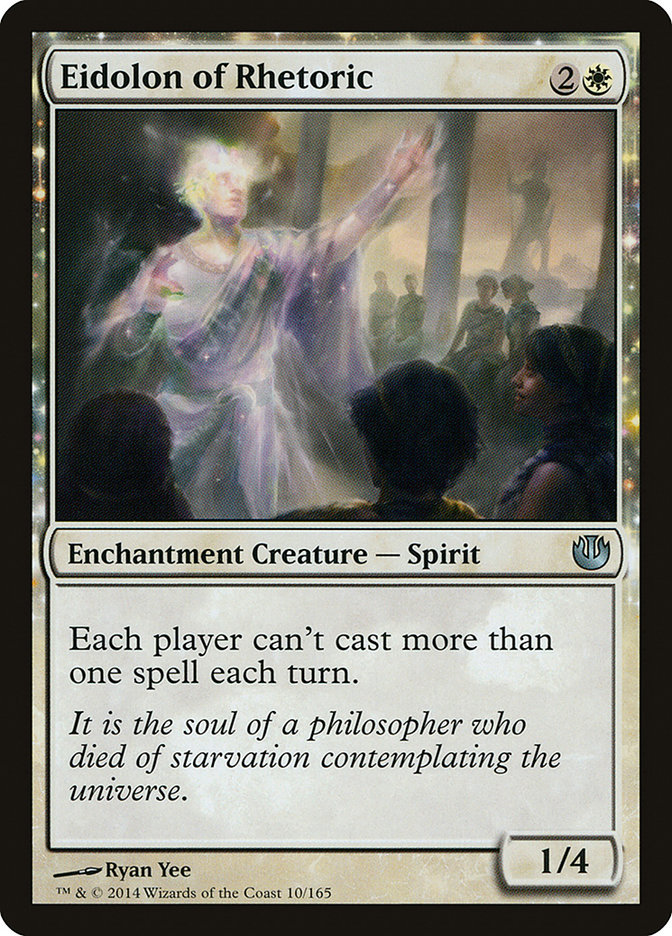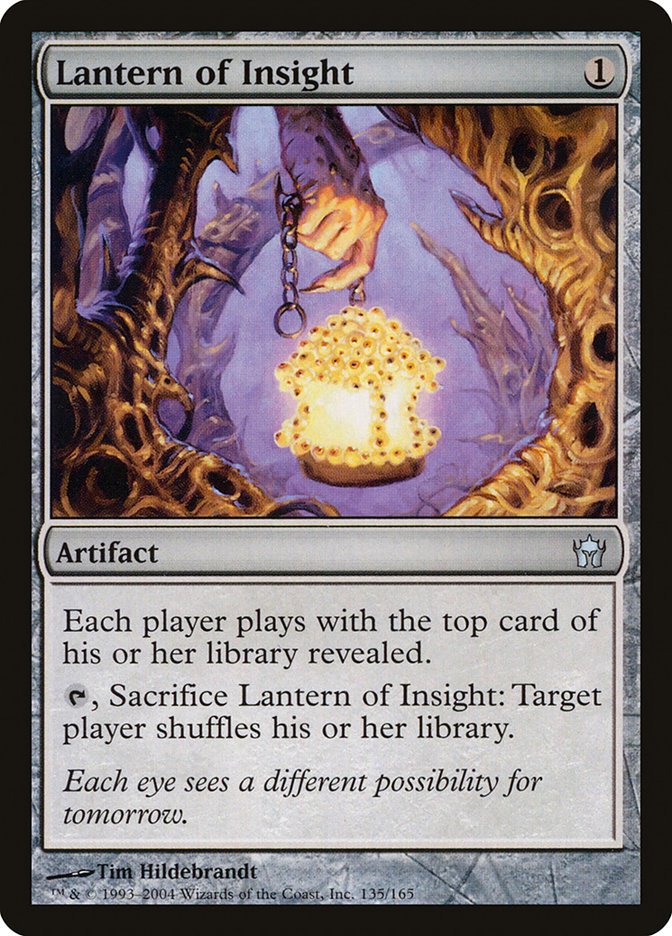When it comes to Constructed tournament Magic, Standard and Modern are at the top of the heap, with every other format lagging behind. Having both of them gives us as players some variety in our tournaments, and that variety comes through in how differently the two formats play out.
Typically, Standard is highly dynamic; sometimes the best deck changes each week until the format settles. And even once the format has settled, it’s important to keep up to date with common sideboard strategies and react to them to keep your edge.
These metagame edges are important because Standard tends to only have three to five top decks to choose from, so a well-prepared player can be practiced in nearly all the relevant matchups and get a complete picture of the format. Having a narrow range of decks to study also makes metagame predicting easier, so what you prepare for is more likely to be what you come up against in the tournament.
Modern, however, is much wider, with even the top decks only taking 5-10% of the metagame and upwards of twenty different archetypes to prepare for. Having such a wide format makes intimately knowing your deck a bigger advantage, since you’ll have to adjust to unexpected decks and sideboard strategies on the fly and you’ll likely run into some opponents who are unprepared for your deck of choice. Metagame advantages in this kind of format are indeed smaller, but that doesn’t mean there is nothing to be gained from studying the Modern metagame.
If you look generally, there are broad trends that Modern tends to follow, and being aware of them will help you see when it’s time to switch from your pet deck and expand your repertoire. The most successful Modern players have a range of decks they are comfortable with. When one deck becomes poorly positioned, they can switch to another that isn’t without losing their deck familiarity edge. Understanding the Modern metagame will also give you the tools necessary to create the right group of decks for your arsenal.
The Modern Metagame Cycle
Ari Lax has done some great work breaking down the web of Modern decks into coherent classes based on strategy, most recently here. This kind of generalizing is what we need to understand how the Modern metagame works in a broad sense, so I’m going to narrow the scope even further.
There may be twenty to 30 decks in Modern, but only a few of them are capable of truly driving the metagame forward by forcing a wholesale reaction in order to contain them. These are the most powerful decks in the format, and you can roughly tell which decks belong in them by checking whether there is a vocal minority of players wishing for their key cards to be banned. Grixis Death’s Shadow, Tron, and Storm all fall into this category.
Creatures (16)
Lands (18)
Spells (26)

Creatures (6)
Planeswalkers (6)
Lands (19)
Spells (29)
- 4 Oblivion Stone
- 4 Sylvan Scrying
- 4 Chromatic Sphere
- 4 Chromatic Star
- 3 Relic of Progenitus
- 4 Expedition Map
- 4 Ancient Stirrings
- 2 Fatal Push
Sideboard

Creatures (8)
Lands (18)
Spells (34)

Beyond this top tier of decks, there are a number of decks that can win and may be a great choice on any given weekend, but they will never be decks that are appropriate to play over the long term if you’re only looking to maximize your win rate.
The decks that drive the Modern metagame fall into three categories: fast combo, heavy disruption, and resilient combo/big mana. In general, fast combo beats resilient combo/big mana, which beats heavy disruption, which beats fast combo. There are some exceptions based on specific interactions but on a strategic level, these are how the matchups play out.
The first matchup plays out mainly as a race; since neither deck has much disruption, speed wins. Of course, that reduced speed means those decks play well against disruption, so they win the second matchup, whereas fast combo is more vulnerable and loses to the heavy disruption decks.
You may be tempted to put every deck in Modern into these categories but remember that this just describes the upper crust of the format. For example, a couple of years ago, I would’ve put Burn among those top decks. Eidolon of the Great Revel was a recent, excellent addition. The deck had a great matchup against Infect and Tron and held its own against Splinter Twin and Jund/Abzan. However, since that time the deck has failed to get better in any capacity, while the rest of the format has advanced significantly.
Burn is now underpowered relative to the rest of the format and requires a very specific metagame to be good, beyond the general trends of this cycle. I think Oklahoma City was a good weekend for the deck, but that window is likely closing soon, if it hasn’t already.
Right now I would put the following decks in the top tier of Modern:
Fast Combo:
Storm
Heavy Disruption:
Jeskai Control
Resilient Combo/Big Mana
TitanShift
Tron
That’s it. Five decks. And if you’re comfortable with one deck in each category, then you’ll be prepared for nearly every Modern tournament, no matter the metagame. Learning three decks is a lot easier than learning 30.
Aside: I really wanted to put Dredge on this list, but the fact that it’s both dependent on having a favorable metagame and that metagame not having a lot of graveyard hate puts it behind these decks.
You may be interested to know that I would slot Dredge with TitanShift and Tron rather than Storm since the deck actually plays quite slowly and doesn’t win the game before Turn 4 or 5 unless your draw is excellent, putting it roughly on par with Scapeshift for speed. Dredge also struggles with big mana decks as well as fast combo while soundly beating the heavy disruption decks, so that placement makes sense.
These are the decks that drive Modern, the decks that you need to be primarily worried about when choosing and tuning your deck for a given weekend. The metagame cycles through periods where each group dominates, and it’s your job to recognize where the metagame cycle is and be a step ahead. A few months ago, Storm was very popular, making the heavy disruption decks a good choice. The metagame moved to a fairer place and we finally saw the major shift toward Tron and TitanShift at Grand Prix Oklahoma City, so we should be moving to a place where Storm is better-positioned.
However, we’re in a weird spot right now with no tournaments for a couple of weeks, so it’s going to be hard to gauge how quickly the metagame will progress through this cycle by the time we play again. Also, because the fast combo section is only one deck, there is the potential for the metagame to continue hating it out with lots of graveyard hate and Eidolon of Rhetorics, thus opening up the format for another combo deck to take advantage, like Ad Nauseam.
It’s not as simple as just picking a deck in the next category and being done with it, but that should be where you begin. Once you have that starting place, you can examine specific metagame conditions such as prevalence of hate toward a given deck, rising Tier 2 decks, and potential dark horse candidates. This is a framework to be used as a jumping off point, not a Magic 8 Ball.
The Affinity Problem
Affinity is consistently among the most played and most successful decks in Modern. Why didn’t it make the list?
Creatures (27)
- 4 Arcbound Ravager
- 4 Ornithopter
- 4 Master of Etherium
- 4 Steel Overseer
- 2 Memnite
- 4 Signal Pest
- 4 Vault Skirge
- 1 Hope of Ghirapur
Lands (17)
Spells (16)
Sideboard

There certainly was a time when having hate for Affinity was critical for sideboards. Shatterstorm and Creeping Corrosion showed up frequently as the big guns alongside Ancient Grudges galore.
But does anyone have specific Affinity hate anymore? The closest thing we have is playing Kozilek’s Return over the other small red sweepers in order to answer creature-lands and Etched Champion. Affinity is good, it’s omnipresent, but it’s not among the decks that truly drive the format anymore. It’s just in the background.
That puts the deck in a weird spot where I wouldn’t begrudge anyone for playing it, but I’m not going to group it with the cycle decks. Sorry, Alex Majlaton!
Broken Metagames
In any format, it’s important to understand when a metagame is broken to the point where it’s correct to play a certain deck regardless of other considerations. How can this metagame cycle framework help us to make those decisions?
The cycle depends on its rock-paper-scissors nature. Each category of deck defeats one category and loses to the other. Each category has a prey and a predator. That’s what causes the metagame to progress through each of them and maintain balance. However, if a deck can beat both other categories, it becomes dominant and the metagame breaks. In fact, it doesn’t even need to soundly beat its predator deck. If it can simply compete against its predator and break even, that will be enough to put it ahead of the pack.
This happened last fall with Dredge, because the presence of Golgari Grave-Troll made the deck explosive enough to compete with fast combo and race big mana strategies. Casting the card was also a quality win condition against Grafdigger’s Cage and Surgical Extraction on your other creatures, making the deck more resilient to hate.
We also had Infect, another fast combo deck that was resilient enough to compete against heavy disruption strategies because of the power of Gitaxian Probe and Become Immense. This led to a format that was heavily warped around fast combo decks, much to the chagrin of many players.
If we get to a point where one of these decks can beat its predator, play it until something is banned.
Cycle Disruptions
Of course, the one constant in Magic is change. New cards are printed every three months, and while most sets only have a few cards that impact Modern, that impact can still be significant. New cards can bolster a previously Tier 2 deck into Tier 1 territory or cause the development of a completely new deck, potentially disrupting the metagame cycle in progress.
Even if a deck isn’t broken, if it’s new and powerful enough, it will take some time for the rest of the format to properly react to it, leading to a brief period where it dominates the format. Over this last year we saw this process play out with Death’s Shadow variants. The printing of Fatal Push allowed for fair decks built around the powerful one-drop to emerge, first as Jund and then later as Grixis, with nearly every other variant tried in the intervening time.
Grixis Death’s Shadow was the undeniable best deck for long enough that it got some ban chatter, but the metagame did eventually react to it. In reality, they were reacting to Fatal Push. Fatal Push supplanted Lightning Bolt as the top removal spell of the format and pushed the premier black threats, Death’s Shadow, Gurmag Angler, and Tasigur, the Golden Fang, to the forefront.
Path to Exile re-emerged to answer the delve threats, and eventually several three-mana creatures that were formerly weak to Lightning Bolt started seeing play, as they could punish players for having a Fatal Push without revolt. Spell Queller, Mantis Rider, Elvish Archdruid, and Goblin Rabblemaster are all good examples of these creatures.
It’s only recently that the format settled into a normal cycle after Fatal Push, and we’re about to get another new set that could throw everything out of whack again. But hey, that’s Magic. As new decks rise and old decks fall, you’ll need to adjust the above decks accordingly but the general texture of the format and the broad categories those decks fall into will remain the same.
A New Potential Disruptor
Even before Rivals of Ixalan, a new challenger is emerging in Modern. That is the Mono-Blue Living End deck with As Foretold:
Creatures (14)
Lands (21)
Spells (25)

As Foretold is a clearly powerful card and it’s been tried in several shells, from U/W Control to Taking Turns, but this is the most promising one yet. It fully maximizes the potential of As Foretold with eight suspend spells to cast immediately with the enchantment and a bunch of counterspells so you can cast multiple free spells in one turn cycle.
Living End is a proven card in Modern and this deck maximizes its usage as a sweeper to play a control game while having the ability to put ten or more power onto the battlefield as early as Turn 3. I don’t know exactly what category this deck falls in because it’s so versatile, but it’s a deck to watch out for in the coming weeks.
The Secret Sixth Deck
I know I only listed five decks as Tier 1 above, but I’m pretty sure there’s a sixth, and most of you aren’t going to like it:
Lands (18)
Spells (42)

Lantern Control has been rising in popularity since the printing of Whir of Invention, giving it the level of consistency it needed to assemble its lock in time in every matchup.
This is another strange deck to categorize, but I’d put it in the heavy disruption category, since that’s what the deck is ultimately trying to do, even if it doesn’t do it in a traditional way. Also, Tron is among its worst matchups, so that categorization best preserves the cycle structure. You have several weeks before the Modern Open in Columbus, and I expect the field that weekend to be underprepared specifically for Lantern Control.
Lantern is one of those decks that people hate to play, and that causes it to be underrepresented (players that would otherwise gravitate to it when it’s good refuse to play it), and for players to be unprepared for the matchup because they don’t like playtesting against it or can’t find someone to pilot the Lantern side effectively.
Whether or not Lantern can continue to thrive with a target on its back is the single question I’m most looking to answer in the next month. If Whir of Invention and Ancient Stirrings give the deck enough redundancy to wade through hate, we could be looking at a dominant deck.
Metagaming in Modern is certainly a more complicated process than it is in Standard, and it requires some simplifying assumptions in order to hew the problem down to size, but there are lessons to be internalized and carried forward for those who put in the work. In a game of small edges, it’s important to capitalize on each and every one available. Put in some work with other Modern decks. The next time your pet deck is a bad choice, you won’t be left behind.




